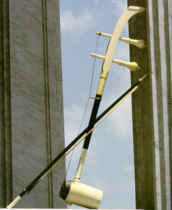|
Saw Sam Sai The Thai instrument known as the saw sam sai is somewhat like the Japanese shamisen and the Chinese san hsien in that all are three—stringed instruments with no frets on the neck. The Japanese and Chinese instruments, however, have square sound boxes and are plucked with plectrum. The san hsien has more rounded corners on the sound box than does the Japanese instrument and is covered with snakeskin, whereas the shamisen of Japan is covered with a thin, animal hide. As for the saw sam sai of Thai, it is a bowed instrument with a somewhat triangular body and one spiked leg. The instrument much more resembles its Middle Eastern predecessor, the rebec or rebab than it does the other Asian stringed instruments. The body of the saw sam sai is made from half a coconut shell. The half which is used must have three bulges in the formation of the points of a triangle. This forms the back part of the resonance chamber. The open part of the shell is covered with goat-or calfskin. The size and pitch of the instrument depend on the size of the coconut shell which may be found.
|
|
Saw
U The saw u is a two-stringed instrument. The head is made of a rather large coconut shell without lumps and more of an oval shape. The saw u is very similar to a two-stringed Chinese instrument called u-hu, but the Chinese instrument has frets along the neck which the Thai instrument does not. Also the tuning pegs of the u hu are to the right of the player. At the place where the tuning pegs are inserted in the neck of the Chinese instrument, a long groove is cut into the neck and the strings fit into these grooves and are tied to the tuning pegs after passing through the groove. This instrument has a low tone. The name of the Thai instrument comes from the characteristic sound that the Thais hear when the instrument is played, just as the Chinese gave their instrument a name according to the sound they heard it produce. The pattern or model for the saw u was probably taken from the Chinese instrument.
|
|
Saw Duang The saw duang is similar to the Chinese stringed instrument called hu chin, and may have been copied from this Chinese model. The name saw duang may come from the fact that the instrument resembles a certain kind of snare or trap which is used to catch a type of edible lizard which is eaten by the people in the northern provinces. This trap is called a duang dak yae and is also made of bamboo. So the name of this instrument may come from its shape rather than from the sound produced when it is played.
|


